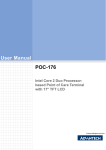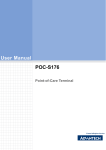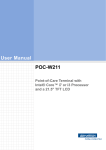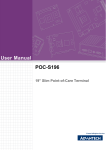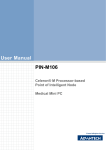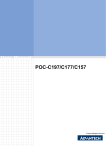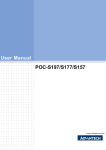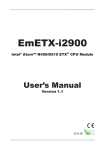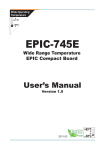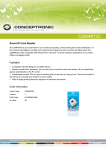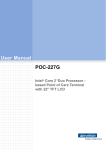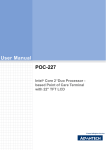Download User Manual POC-196
Transcript
User Manual POC-196 Intel Core 2 Duo Processorbased Point of Care Terminal with 19" TFT LCD Instructions for the User The document combines text and illustrations, providing a comprehensive overview of the system. The information is presented as a sequential steps of action, allowing the user to learn directly how to use the device. The text provides explanations and instructs the user step-by-step in the practical use of the product, with short, clear instructions in easy-to-follow sequence. Definitions Warning! A WARNING statement provides important information about a potentially hazardous situation which, if not avoided, could result in death or serious injury. Caution! A CAUTION statement provides important information about a potentially hazardous situation which, if not avoided, may result in minor or moderate injury to the user or patient or in damage to the equipment or other property. Note! A NOTE provides additional information intended to avoid inconveniences during operation. POC-196 User Manual Part No. 2008019610 Edition 1 Printed in Taiwan April 2009 ii Safety Instructions Strictly follow these Instructions for Use. Please read these safety instructions carefully. You are reminded to keep this User's Manual for later reference, and any use of the product requires full understanding and strict observation of all portions of these instructions. Observe all WARNINGS and CAUTIONS as rendered throughout this manual and on labels on the equipment. Repair of the device may also only be carried out by trained service personnel. Advantech recommends that a service contract be obtained with Advantech Service and that all repairs also be carried out by them. Otherwise the correct functioning of the device may be compromised. Warning! Because of the danger of electric shock, never remove the cover of a device while it is in operation or connected to a power outlet. If one of the following situations arises, have the equipment checked by service personnel: a. The power cord or plug is damaged. b. Liquid has penetrated the equipment. c. The equipment has been exposed to moisture. d. The equipment does not work well, or you cannot get it to work according to the user's manual. e. The equipment has been dropped and damaged. f. The equipment has obvious signs of breakage. Disconnect this equipment from any AC outlet before cleaning. Use a damp cloth. Do not use liquid or spray detergents for cleaning and keep this equipment away from humidity. Caution! To avoid short-circuits and otherwise damaging the device, do not allow fluids to come in contact with the device. If fluids are accidentally spilled on the equipment, remove the affected unit from service as soon as possible and contact service personnel to verify that patient safety is not compromised. Put this equipment on a reliable surface during installation. Dropping it or letting it fall may cause damage. For plug-in equipment, the power outlet socket must be located near the equipment and must be easily accessible. Caution! To prevent overheating, it is recommended to install the unit in an upright position. Do not lie it flat on a table and do not cover the openings or place the device in direct sunlight or near radiant heaters. Make sure the voltage of the power source is correct before connecting the equipment to the power outlet. Position the power cord so that people cannot step on it. Do not place anything over the power cord. If the equipment is not used for a long time, disconnect it from the power source to avoid damage by transient over voltage. iii POC-196 User Manual Caution! Do not leave this equipment in an uncontrolled environment where the storage temperature is below -20°C (-4°F) or above 60°C (140°F). This may damage the equipment. If your computer clock is unable to keep accurate time or the BIOS configuration resets to default, please check the battery. Caution! Do not replace the battery yourself. Please contact a qualified technician or your retailer. The computer is provided with a battery-powered real-time clock circuit. There is a danger of explosion if battery is incorrectly replaced. Replace only with same or equivalent type recommended by the manufacturer. Discard used batteries according to the manufacturer’s instructions. Improper installation of VESA mounting can result in serious personal injury! VESA mount installation should be completed by a professional technician, please contact the service technician or your retailer if you need this service. The detailed installation procedure is specified in Appendix A. CLASSIFICATION: ! Supply Class I adapter ! No applied parts ! IPX1 ! Continuous operation ! Not AP or APG category Warning! This device is not suitable for use in the presence of flammable anesthetic mixtures with air, oxygen, nitrous oxide, or as a life support system. Maintenance: To properly maintain and clean the surfaces, use only the approved products or clean with a dry applicator. Caution! When servicing the device, always use replacement parts that meet Advantech standards. Advantech Medical cannot warrant or endorse the safe performance of third-party replacement parts for use with our medical device. Make sure users do not come in contact with SIP/SOPs and the patient at the same time. POC-196 User Manual iv When connecting electrical devices, the operator is responsible for ensuring that the resulting system meets the requirements set forth by the following standards: EN 60601-1 (IEC 60601-1) Medical electrical equipment Part 1: General requirements for safety EN 60601-1-1 (IEC 60601-1-1) Medical electrical equipment Part 1-1: General requirements for safety Collateral standard: Safety requirements for Medical electrical systems EN 60601-1-2 (IEC 60601-1-2) Medical electrical equipment Part 1-2: General requirements for safety Collateral standard: Electromagnetic compatibility; Requirements and tests Accessory equipment connected to the analog and digital interfaces must be in compliance with the respective nationally harmonized IEC standards (i.e. IEC 60950 for data processing equipment, IEC 60065 for video equipment, IEC 61010-1 for laboratory equipment, and IEC 60601-1 for medical equipment). Furthermore all configuration should comply with the system standard IEC 60601-1-1. Anyone who connects additional equipment to the signal input or signal output is configuring a medical system, and is therefore responsible that the system complies with the requirements set forth in standard IEC 60601-1-1. The unit is for exclusive interconnection with IEC 60601-1 certified equipment in the patient environment and IEC 60XXX certified equipment outside of the patient environment. If in doubt, consult the technical services department or your local representative. v POC-196 User Manual FCC Class B This equipment has been tested and found to comply with the limits for a Class B digital device, pursuant to Part 15 of the FCC Rules. These limits are designed to provide reasonable protection against harmful interference when the equipment is operated in a residential environment. This equipment generates, uses, and can radiate radio frequency energy. If not installed and used in accordance with this user's manual, it may cause harmful interference to radio communications. Note that even when this equipment is installed and used in accordance with this user's manual, there is still no guarantee that interference will not occur. If this equipment is believed to be causing harmful interference to radio or television reception, this can be determined by turning the equipment on and off. If interference is occurring, the user is encouraged to try to correct the interference by one or more of the following measures: ! Reorient or relocate the receiving antenna. ! Increase the separation between the equipment and the receiver. ! Connect the equipment to a power outlet on a circuit different from that to which the receiver is connected. ! Consult the dealer or an experienced radio/TV technician for help. Warning! Any changes or modifications made to the equipment which are not expressly approved by the relevant standards authority could void your authority to operate the equipment. List of Accessories Before installing your Point-of-Care Terminal, ensure that the following materials have been received: ! POC-196 series Point-of-Care Terminal ! Accessories for POC-196 – CD-ROM disc-"Drivers, User's manual and Utilities” – Mounting kits and packet of screws – VESA mounting note x1 – China RoHs note x1 Warning! No user serviceable parts inside, refer servicing to qualified personnel. Only the accessories indicated on the list of accessories above have been tested and approved to be used with the device. It is strongly recommended that only these accessories be used in conjunction with the specific device. Otherwise the correct functioning of the device may be compromised. POC-196 User Manual vi Additional Information and Assistance Contact your distributor, sales representative, or Advantech's customer service center for technical support if you need additional assistance. Please have the following information ready before you call: ! Product name and serial number ! Description of your peripheral attachments ! Description of your software (operating system, version, application software, etc.) ! A complete description of the problem ! The exact wording of any error messages ! This equipment is a source of electromagnetic waves. Before use please make sure that there are not EMI sensitive devices in its surrounding which may otherwise malfunction. Manufacturer Advantech Co., Ltd. No.1, Alley 20, Lane 26, Rueiguang Road Neihu District, Taipei, Taiwan 11491, R.O.C. TEL: (02) 2792-7818 Distributed in Europe by: Advantech Europe GmbH Kolberger Straße 7 D-40599 Düsseldorf, Germany Tel: 49-211-97477350 Fax: 49-211-97477300 Visit the Advantech websites at www.advantech.com or www.advantech.com.tw if you need more information. vii POC-196 User Manual POC-196 User Manual viii Contents Chapter Chapter 1 General Information ............................1 1.1 1.2 1.3 Introduction ............................................................................................... 2 Specifications ............................................................................................ 2 Dimensions ............................................................................................... 5 Figure 1.1 Dimensions of the POC-196....................................... 5 2 System Setup .......................................7 2.1 A Quick Tour of the POC-196 ................................................................... 8 Figure 2.1 Front View of the Point of Care terminal..................... 8 Figure 2.2 Rear view of the Point-of-Care Terminal .................... 9 Figure 2.3 Rear View of the Point of Care Terminal I/O Ports..... 9 Figure 2.4 Side View of the Point of Care Terminal I/O Ports ... 10 Installation Procedures............................................................................ 10 2.2.1 Connecting the Power Cord........................................................ 10 Figure 2.5 Connecting the Power Cord ..................................... 11 2.2.2 Switch on the Power ................................................................... 11 Figure 2.6 Press the Power Button to Boot System ................. 11 Running the BIOS Setup Program .......................................................... 11 Installing System Software...................................................................... 12 Installing the Drivers................................................................................ 12 Figure 2.7 File Directory "Drivers and Utilities” CD-ROM .......... 13 2.2 2.3 2.4 2.5 Chapter 3 Chipset and Graphics Setup ............15 3.1 Introduction ............................................................................................. 16 3.1.1 Chipset........................................................................................ 16 3.1.2 Display Memory .......................................................................... 16 3.1.3 DVI Transmitter........................................................................... 16 3.1.4 Display Types ............................................................................. 16 Installation of Chipset Driver ................................................................... 17 3.2.1 Installation for Windows XP ........................................................ 18 3.2 Chapter Chapter Chapter 4 Audio Interface ..................................25 4.1 4.2 4.3 Introduction ............................................................................................. 26 Installation of Audio Driver ...................................................................... 26 4.2.1 Installation for Windows 2000/XP ............................................... 27 Further Information.................................................................................. 28 5 PCI Express Ethernet Interface ........29 5.1 5.2 5.3 Introduction ............................................................................................. 30 Installation of the Ethernet Driver............................................................ 30 5.2.1 Installation for Windows XP ........................................................ 30 Further Information.................................................................................. 32 6 Touch Panel Interface .......................33 6.1 Introduction ............................................................................................. 34 ix POC-196 User Manual 6.2 Chapter Chapter Chapter 6.3 Installation of Touch Panel Driver ........................................................... 34 6.2.1 Installation for Windows XP ........................................................ 34 Further Information ................................................................................. 39 7 1394b Interface.................................. 41 7.1 7.2 7.3 Introduction ............................................................................................. 42 Driver Installation .................................................................................... 42 Further Information ................................................................................. 46 8 Smart Card Reader Interface ........... 47 8.1 8.2 Introduction ............................................................................................. 48 Driver Installation .................................................................................... 48 9 Utilities and Hot Fix .......................... 51 9.1 9.2 Introduction ............................................................................................. 52 Wake up by External USB Device at S3 Resume (Wake up) ................. 52 9.2.1 Installation for Windows XP ........................................................ 52 Window Audio Volume Application ......................................................... 52 9.3.1 Installation for Windows XP ........................................................ 52 9.3 Chapter 10 Operational Information ................... 53 10.1 10.2 10.3 10.4 Plug in the Power Adapter ...................................................................... 54 Thermal................................................................................................... 54 Disconnect the Power ............................................................................. 54 General Safety Guide ............................................................................. 55 Appendix A Description of MB Connectors ........ 57 A.1 Description of MB Connectors ................................................................ 58 Figure A.1 Top View POC-196 Motherboard with Connectors .. 58 Appendix B Windows Display Hot Key Function 61 B.1 Windows Display Hot Key Function ........................................................ 62 Appendix C PCM-8702 Jumper Setting................ 63 C.1 Jumper Locations.................................................................................... 64 Figure C.1 Jumper Locations ..................................................... 64 Table C.1: CN33 COM1 Pin 9 Output Configuration ................. 64 Table C.2: CN39 COM2 Pin 9 Output Configuration ................. 65 Table C.3: CN41 COM3 Pin 9 Output Configuration ................. 65 Table C.4: CN35 COM1 RS232/422/485 Output Type Setting.. 65 Table C.5: CN50 Internal USB Port 5 and Port 6....................... 66 POC-196 User Manual x Chapter 1 1 General Information Sections include: ! Introduction ! Specifications ! Dimensions 1.1 Introduction The POC-196 is a multimedia Intel Core 2 Duo Mobility processor-based computer that is designed to serve as a Point of Care terminal (POC.) It is a PC-based system with 19" color TFT LCD display, a single DVI-I Port, dual on-board 10/100/1000 PCIE Ethernet controller, quad COM ports, quad USB 2.0 ports and a 24-bit stereo audio controller. With an optional 2.5" SATA HDD drive, the POC-196 is an user-friendly computer. For system integrators, this highly integrated multimedia system lets you easily build a Point of Care terminal into your applications. The POC-196 makes it an ideal and safe point of care solution for patients and hospital practitioners. The POC-196 is specially designed to resist spills and water damage, and ensures dust resistance with its protected LCD, and sealed ports. The high contrast ratio (1300:1) of POC-196 makes it a perfect image terminal for PACS and DICOM applications. The POC-196 is a reliable solution to your application's processing requirements. 1.2 Specifications Chipset 945GME/ ICH7M Chipset CPU Intel® Core 2 Duo Processor T7400 (2.16 GHz 667 MHz 4 MB Unified 34 watts 1.1625 V-1.3 V 100°C 478μFC-PGA) Front Side Bus 533/667 MHz Memory DDR2 533/667 Unbuffered Non ECC SO-DIMM sockets x 2 (max. 4 GB) * Due to standard PC architecture, a certain amount of memory is reserved for system usage and therefore the actual memory size is less than the stated amount. Controller Intel GMA 950 Graphics technology Up to 224 MB of DVMT for graphics memory Mini PCIe 1 x Mini PCI slot, supports type IIIA Mini PCI PCI 2.2 1 x PCI 2.2, accept low profile PCI Card Storage HDD 1 x 2.5” SATA Ethernet Interface 2 x Gigabit Ethernet (isolated) interface (RJ-45) Computing System Graphics Expansion Slot Identification 1 x Smart card reader I/O Ports 2 x RS-232(isolated), 1x RS-232 and 1x RS232/ 422/485(isolated) serial port; 4 x USB 2.0 ports; 1 x IEEE 1394b ports 1 x PS/2 mouse and K/B; 1 x DVI-I VGA port; Speakers 2 x 1 W speakers; 1 x MIC-in and Speaker-out POC-196 User Manual 2 Max. Resolution 1280 x 1024 Max. Colors 16.7M (RGB 8 bits/color) Dot size (mm) 0.294 (per triad) x 0.294 Viewing angle 178°/178° Luminance 300 cd/m2 Contrast ratio 1300 : 1 LCD MTBF 50,000 hours Backlight lifetime 50,000 hours at 6.5 mA AC Model Internal ATX power supply Input voltage 100 ~ 240 VAC, 5/3 A max. @ 50 ~ 60 Hz Output voltage +3.3 V @ 16 A, +5 V @ 18 A, +12 V1 @ 16 A, +12 V2 @ 16 A, +5 Vsb @ 2.5 A, -12 V@ 0.5 A, -5 V @ 0.2 A(300W) Type Analog Resistive Resolution Continuous Light transmission 75% Controller RS-232 interface (use COM5) Durability 30 million touches CE,FCC approved Certification Environment Physical Characteristics UL60601-1,EN60601-1 approved Temperature 0 ~ 40° C (32 ~ 104° F) (Operating) Humidity 10 ~ 95% @ 40°C (non-condensing) Shock Resistance 30G peak acceleration (11ms duration) Power MTBF 100,000hrs Water/dust Resistance IPX1 compliant Dimensions (W x H x D) 471.5 x 416.2 x 123.6 mm (18.56” x 16.38” x 4.87”) Weight 10.5 kg 3 POC-196 User Manual General Information 19" TFT LCD. Power Supply Optional Touchscreen Chapter 1 Display Display type Cleaning/Disinfecting During normal use, the Tablet PC may become soiled and should, therefore, be cleaned regularly. Agents: Green tinctured soap and Enzymatic detergents Steps: 1. Wipe the Tablet PC with a clean cloth that has been moistened in the cleaning solution. 2. Prepare agent per manufacturer's instructions or hospital protocol. 3. Wipe thoroughly with a clean cloth Caution! Do not immerse or rinse the POC-196 and its peripherals. If you accidentally spill liquid on the device, disconnect the unit from the power source. Contact your Biomed unit regarding the continued safety of the unit before placing it back in operation. Do not spray cleaning agent on the chassis. Do not use disinfectants that contain phenol. Do not autoclave or clean the POC-196 or its peripherals with strong aromatic, chlorinated, ketone, ether, or Esther solvents, sharp tools or abrasives. Never immerse electrical connectors in water or other liquids. Note! The Point of Care terminal with the optionally installed touchscreen will share COM5. Once the touchscreen is installed, COM5 cannot be used for other purposes. Optional Modules ! Memory: 1GB, 2GB DDR2 533/667MHz DRAM ! HDD: 2.5" SATA HDD ! Touchscreen: Analog resistive POC-196 User Manual 4 Chapter 1 1.3 Dimensions General Information Figure 1.1 Dimensions of the POC-196 5 POC-196 User Manual POC-196 User Manual 6 Chapter 2 2 System Setup Sections include: ! A Quick Tour of the POC-196 ! Installation Procedures ! Running the BIOS Setup Program ! Installing System Software ! Installing the Drivers 2.1 A Quick Tour of the POC-196 Before you start to set up the POC-196, take a moment to become familiar with the locations and purposes of the controls, drives, connections and ports, which are illustrated in the figures below. When you place the POC-196 upright on the desktop, its front panel appears as shown in Figure 2.1. Figure 2.1 Front View of the Point of Care terminal When you turn the Point of Care terminal around and look at its rear cover, the sunken I/O section is at the bottom of the panel PC, as shown in Figure 2.2. (The I/O section includes various I/O ports, including serial ports, DVI port, the Ethernet port, USB ports, the DC power adapter jack, and so on. Ethernet & RS-232 I/O Connectivity has a special port isolation design.) Figure 2.2 Rear view of the Point-of-Care Terminal POC-196 User Manual 8 Chapter 2 When you turn the Point of Care Terminal around and look at its left side and remove the side cover, the sunken I/O section is at the left of the panel PC, as shown in Figure 2.3. The I/O section includes various I/O ports, including 1394b port, USB port, Smart card reader and optical device. Figure 2.4 Side View of the Point of Care Terminal I/O Ports 9 POC-196 User Manual System Setup Figure 2.3 Rear View of the Point of Care Terminal I/O Ports 2.2 Installation Procedures 2.2.1 Connecting the Power Cord The POC-196 is powered only by an AC power cord. Always handle the power cords by holding the plug ends only. Follow these procedures in order: 1. Prepare the POC-196 2. Connect the 3-pin male plug of the power cord to an electrical outlet. 3. Separate Purchase Figure 2.5 Connecting the Power Cord 2.2.2 Switch on the Power Switch on the reset switch on the front cover. (See Figure 2.6.) Figure 2.6 Press the Power Button to Boot System POC-196 User Manual 10 2.4 Installing System Software Recent releases of operating systems from major vendors include setup programs which load automatically and guide you through hard disk preparation and operating system installation. The guidelines below will help you determine the steps necessary to install your operating system on the panel PC hard drive. Note! Some distributors and system integrators may have already preinstalled system software prior to shipment of your panel PC. If required, insert your operating system's installation or setup diskette into the external diskette drive until the release button pops out. The BIOS supports system boot-up directly from the CD-ROM drive. You may also insert your system installation CD-ROM disk into your external CD-ROM drive. Power on or reset the system by pressing the "Ctrl+Alt+Del" keys simultaneously. The Point-of-Care terminal will automatically load the operating system from the diskette or CD-ROM. If you are presented with the opening screen of a setup or installation program, follow the instructions on screen. The setup program will guide you through preparation of your hard drive, and installation of the operating system. 11 POC-196 User Manual System Setup Your POC-196 is likely to have been properly set up and configured by your dealer prior to delivery. You may still find it necessary to use the BIOS (Basic Input-Output System) setup program to change system configuration information, such as the current date and time or your type of hard drive. The setup program is stored in readonly memory. It can be accessed either when you turn on or reset the panel PC, by pressing the " Crtl+Alt+Del " key on your keyboard immediately after powering on the computer. The settings you specify with the setup program are recorded in a special area of memory called CMOS RAM. This memory is backed up by a battery so that it will not be erased when you turn off or reset the system. Whenever you turn on the power, the system reads the settings stored in CMOS RAM and compares them to the equipment check conducted during the power on self-test (POST). If an error occurs, an error message will be displayed on screen, and you will be prompted to run the setup program. Chapter 2 2.3 Running the BIOS Setup Program 2.5 Installing the Drivers After installing your system software, you will be able to set up the Chipset, Graphics, Ethernet, audio and touchscreen functions from your own external CD-ROM drive. All the drivers except the CD-ROM drive driver are stored in a CD-ROM disc entitled "Drivers and Utilities.” The standard procedures for installing the Chipset, Graphics, Audio and Ethernet drivers are described in Chapters 3, 4, 5, and 6 respectively. The various drivers and utilities in the CD-ROM disc have their own text files which help users install the drivers and understand their functions. These files are a very useful supplement to the information in this manual. For your reference, the directory of drivers on the "Drivers and Utilities” CD-ROM is: Figure 2.7 File Directory "Drivers and Utilities” CD-ROM Note! The drivers and utilities used for the POC-196 panel PCs are subject to change without notice. If in doubt, check Advantech's website or contact our application engineers for the latest information regarding drivers and utilities. POC-196 User Manual 12 Chapter 3 3 Chipset and Graphics Setup Sections include: ! Introduction ! Installation of Chipset Driver 3.1 Introduction The POC-196 has an onboard display interface. The specifications and features are described in the following section: 3.1.1 Chipset The POC-196 uses Mobile an Intel® 945GME Express chipset for its graphic controller. It supports an SDVO device, and CRT monitors. The Mobile Intel® 945GM Express Chipsets are designed for use with Intel’s next generation mobile platform, Intel® Centrino® Duo processor technology. The Mobile Intel 945 Express Chipset Family come with the Generation 3.5 Intel Integrated Graphics Engine, and the Intel® Graphics Media Accelerator 950 (Intel® GMA 950), providing enhanced graphics support over the previous generation Graphics and Memory Controller Hubs (GMCH’s). 3.1.2 Display Memory Dynamic Video Memory Technology (DVMT) 3.0 dynamically allocates up to 128 MB of system memory for graphics usage. 3.1.3 DVI Transmitter The POC-196 uses Chrontel CH7307C for driving its DVI Ports. The CH7307C is a Display Controller device, which accepts digital graphics input signal, encodes and transmits data through a DVI link (DFP can also be supported). The device accepts one channel of RGB data over three pairs of serial data ports. The DVI processor includes a low jitter PLL for generation of the high frequency serialized clock, and all circuitry required to encode, serialize and transmit the data. The CH7307C is able to drive a DVI display at a pixel rate of up to 165 MHz, supporting UXGA (1600 x 1200) resolution displays. 3.1.4 Display Types POC-196 supports Single DVI-I jack for single monitor. The DVI-I Jack support both DVI Digital I/F and CRT RGB signal. Analog CRT DAC interface supports max DAC frequency up to 400 MHz, 24-bit RAMDAC, DDC2B compliant, and resolution up to QXGA 2048 x 1536. POC-196 User Manual 16 Complete the following steps to install the Chipset driver. Follow the procedures in the flow chart that apply to the operating system that you are using within your POC196. Important! The following windows illustrations are examples only. You must follow the flow chart instructions and pay attention to the instructions which appear on your screen. The CD-ROM drive is designated as “D” throughout this chapter. Note! <Enter> means pressing the “Enter” key on the keyboard. Note! Before you install the POC-196 graphics driver, please ensure you have installed the “Intel Chipset Software Installation Utility”. You can find this driver in the Utility CD-ROM. Note! The resolution of the Windows display will be fixed at 640 x 480 before you install the graphics driver. Depending on your monitor’s native resolution, the black area might be different. 17 POC-196 User Manual Chipset and Graphics Setup Note! Chapter 3 3.2 Installation of Chipset Driver 3.2.1 Installation for Windows XP Step 1-1: Double Click “setup.exe” in D:\CHIPSET folder. The Install dialog will appear. Step 1-2: Click 'Next' to continue. Step 1-3: Read the License Agreement and click “Yes” to proceed. POC-196 User Manual 18 19 POC-196 User Manual Chipset and Graphics Setup Step 1-5: When the 'Setup COMPLETE' message appears click 'Finish' to restart your computer. Chapter 3 Step 1-4: Read the file information screen and click “Next” to proceed. Step 2-1: Double Click “setup.exe” in D:\Driver\GRAPHICS folder. The Install dialog will appear. Step 2-2. Click 'Next' to continue. Step 2-3. Read the License Agreement and click “Yes” to proceed. POC-196 User Manual 20 21 POC-196 User Manual Chipset and Graphics Setup Step 2-5. When the 'Click Next to continue' message appears click 'Next' to proceed. Chapter 3 Step 2-4. Read the file information screen and click “Next” to proceed. Step 2-6. When the 'Setup Is Complete' message appears click 'Finish' to restart your computer. POC-196 User Manual 22 Chapter 4 4 Audio Interface Sections Include: ! Introduction ! Installation of Audio Driver ! Further Information 4.1 Introduction The POC-196's onboard audio interface provides high-quality stereo sound by using the ALC888 audio controller from Realtek. The ALC888 series are high performance 7.1+2 channel High Definition Audio Codecs providing ten DAC channels that simultaneously support 7.1 sound playback, plus 2 channels of independent stereo sound output (multiple streaming) through the front panel stereo outputs. All analog jacks are input and output capable, and headphone amplifiers are also integrated at each analog output. All analog I/Os can be re-tasked according to user’s definitions, or automatically switched depending on the connected device type. 4.2 Installation of Audio Driver Before installing the audio driver, please take note of the procedures detailed below. You must know which operating system you are using on your POC-196, following the steps in the corresponding installation flow chart. You can quickly and successfully complete the installation, even if you are not familiar with instructions for Windows. This setup program will install the audio driver and Realtek utility into your system. Important! The following Windows illustrations are examples only. You must follow the flow chart instructions and pay attention to the instructions which appear on your screen. Note! The CD-ROM drive is designated as “D” throughout this chapter. Note! <Enter> means pressing the “Enter” key on the keyboard. POC-196 User Manual 26 1. 2. Double Click “setup.exe” in D:\AUDIO folder. The Install dialog will appear. Click “Next” to continue. The install program will install the driver and utility. It will spend a period of time processing. Chapter 4 4.2.1 Installation for Windows 2000/XP Audio Interface 27 POC-196 User Manual 3. When the 'InstallShield Wizard Complete' message appears click 'Finish' to restart your computer. 4.3 Further Information For further information about the audio interface installation in your POC-196, including Driver updates, troubleshooting guides and FAQ lists, please visit the following web resources: Realtek website: www.realtek.com.tw Advantech websites:www.advantech.com www.advantech.com.tw POC-196 User Manual 28 Chapter 5 5 PCI Express Ethernet Interface Sections include: ! Introduction ! Installation of Ethernet Driver ! Further Information 5.1 Introduction The POC-196 is equipped with the high performance PCIe Ethernet chipset Realtek RTL8111B which is fully compliant with IEEE 802.3 10/100/1000 Mbps standards. The Ethernet port provides a standard RJ-45 jack. 5.2 Installation of the Ethernet Driver 5.2.1 Installation for Windows XP 1. 2. Double Click “Setup.exe” in the D:\Driver\ETHERNET folder. The Install dialog will appear. Click “Next” to continue. POC-196 User Manual 30 4. When the ‘InstallShield Wizard Complete’ message appears click “Finish” to finish the installation program. 31 POC-196 User Manual PCI Express Ethernet Interface Click “Install” to continue. The install program will install the driver. It will spend a period of time processing. Chapter 5 3. 5.3 Further Information For further information about the installation on your POC-196, including Driver updates, troubleshooting guides and FAQ lists, please visit the following web resources: Realtek website: www.realtek.com.tw Advantech websites:www.advantech.com www.advantech.com.tw POC-196 User Manual 32 Chapter 6 6 Touch Panel Interface Sections Include: ! Introduction ! Installation of Touch Panel Driver ! Further Information 6.1 Introduction The POC-196 is supported with a system integrated touch panel. The touch panel controller is controlled by the system COM5 interface. 6.2 Installation of Touch Panel Driver 6.2.1 Installation for Windows XP 1. 2. Double Click “setup.exe” in D:\TOUCH folder. The Install dialog will appear. Click “Next” to continue. POC-196 User Manual 34 Click “Next” to continue. Because POC-196’s touch controller is controlled by COM5, please do not select the “Install PS/2 interface driver”. Chapter 6 3. Touch Panel Interface 35 POC-196 User Manual 4. Click “Next” to continue. Please select “None” for “Do 4 point calibration”. The driver install program will do this 4 point calibration when the install completes. 5. Click “Next” to continue. Please select “Support Multi-Monitor System”. POC-196 User Manual 36 7. Click “Next” to continue. Touch Panel Interface Click “Next” to continue. If you want to change the driver destination folder, you can click the “Browse” button to change the folder. Chapter 6 6. 37 POC-196 User Manual 8. Click “Yes” to continue. The install program will search the touchscreen controller, and find it on COM5. 9. Click “Yes” to continue. Please do 4 point calibration to calibrate the touch screen. POC-196 User Manual 38 Chapter 6 10. Touch 'X' once at each of the 4 corners on the panel. Please touch each “X” icon at the corners until the icon stops blinking. Touch Panel Interface 6.3 Further Information For further information about the installation on your POC-196, including Driver updates, troubleshooting guides and FAQ lists, please visit the following web resources: Advantech websites:www.advantech.com www.advantech.com.tw 39 POC-196 User Manual POC-196 User Manual 40 Chapter 7 1394b Interface Sections include: ! Introduction ! Driver installation ! Further Information 7 7.1 Introduction The POC-196 is supported with a system integrated high speed 1394b interface. The 1394b controller is controlled by the system PCI Express interface. 7.2 Driver Installation 1. 2. Double Click "ubCore32_080808.exe" in the D:\ 1394B Controller folder. The Install dialog will appear. Click 'Next' to continue. POC-196 User Manual 42 Click 'Yes' to continue. 4. Please Key-in "User Name" and "Company Name" then click 'Next' to continue. (eg: "abc" and "Advantech") Chapter 7 3. 1394b Interface 43 POC-196 User Manual 5. Select "Complete", then click 'Next' to continue. 6. Click 'Next' to continue. POC-196 User Manual 44 8. Click 'Finish' to continue. 1394b Interface Click 'Next' to continue. Chapter 7 7. 45 POC-196 User Manual 9. Select "Yes" then click 'Finish' to restart system. 7.3 Further Information For further information about the installation in your POC-176, included Driver updates, troubleshooting guides and FAQ lists, please visit the following web resources. Advantech websites: www.advantech.com www.advantech.com.tw POC-196 User Manual 46 Chapter 8 8 Smart Card Reader Interface Sections include: ! Introduction ! Driver Installation 8.1 Introduction The POC-196 is supported with a system integrated smart card reader interface. The Smart Card reader is built-in to help verify the clinicians' identification. The Smart Card reader controller is controlled by the system USB interface. 8.2 Driver Installation 1. Double Click "SmartCardReader_Driver_Generic_AU9520_4OSVista(x86x64)_Setup_v1.2.4 .16.exe" in D:\Smart Card Reader folder. The Install dialog will appear. POC-196 User Manual 48 The system will auto install the driver. 3. A dialog will show “InstallShield Wizard Complete”; click "Finish". POC-196 User Manual Smart Card Reader Interface 49 Chapter 8 2. POC-196 User Manual 50 Chapter 9 9 Utilities and Hot Fix Sections include: ! Introduction ! Wake up by External USB Device at S3 Resume (Wake up) ! Window Audio Volume Application 9.1 Introduction The POC-196 system needs a specific utility or hot fix to support special functions. 9.2 Wake up by External USB Device at S3 Resume (Wake up) POC-196 support three different sleep (suspend) modes, they are: 1. S1: Power On Suspend: System will stop the clock, turn off the LCD backlight, but keep all power on. The user can press any key (mouse or keyboard) to wake up the system. 2. S3: Suspend to RAM: System will stop the clock, turn off most power, not including memory power. All necessary information will be saved in memory. In this sleep mode, the system needs a Hot fix to be awakened up by USB mouse or keyboard. 3. S4: Suspend to Disk (Hibernation), system will stop the clock, turn off most power, include the memory power. All necessary information will be saved to Hard Disk. In this sleep mode, the user needs to press the power button to wake up the system. 9.2.1 Installation for Windows XP 1. 2. 3. Double click “USBRG.REG” in the D:\Driver\USB folder. Click “Yes” to install this registry information. Click “OK” to close the successful installation information window. 9.3 Window Audio Volume Application On front panel of POC-196 system, there are two buttons to control the speaker volume. This speaker volume is adjustable by pressing the button. It does not need any software utility. However, this speaker volume button cannot modify the Windows volume control if the user has not installed the Advantech Audio Volume application. 9.3.1 Installation for Windows XP 1. 2. 3. 4. Double click the "SETUP.EXE" in D:\Utility\Volume Control folder. Click the "Next" button. Click the "I accept the terms of the license agreement" and click the "Next" button. Click "Finish" to close the complete installation window. POC-196 User Manual 52 Chapter 10 10 Operational Information Sections include: ! Plug in the Power Adapter ! Thermal ! Disconnect the Power ! General Safety Guide 10.1 Plug in the Power Adapter Always leave space around your power adapter. Do not use this equipment in a location where airflow around the power adapter or computer is confined. Always disconnect the power adapter before opening the computer to perform procedures such as installing memory or removing the hard disk. Warning! Use only the power adapter that came with your POC-196 system. Adapters for other electronic devices may look similar, but they may damage your computer. 10.2 Thermal When using your POC-196 system, it is normal for the rear metal heatsink to get warm. The rear metal heatsink of the POC-196 case functions as a cooling surface that transfers heat from inside the computer to the cooler air outside. Do not block this heatsink by any soft material. Warning! Do not place your POC-196 system on a pillow or other soft material when it is on, as the material may block the airflow and cause the computer to overheat. Never place anything on the system case before turning off the computer. Never turn on your computer unless all of its internal and external parts are in place. Operating the computer when it is open or missing parts can be dangerous and can damage your computer. 10.3 Disconnect the Power The only way to disconnect power completely is to unplug the power cord. Make sure at least one end of the power cord is within easy reach so that you can unplug the computer when you need to. Warning! Your AC cord came equipped with a three-wire grounding plug (a plug that has a third grounding pin). This plug will fit only a grounded AC outlet. If you are unable to insert the plug into an outlet because the outlet is not grounded, contact a licensed electrician to replace the outlet with a properly grounded outlet. Do not defeat the purpose of the grounding plug. Warning! Never push objects of any kind into this product through the openings in the case. Doing so may be dangerous and result in fire or a dangerous electric shock. POC-196 User Manual 54 For your own safety and that of your equipment, always take the following precautions. Disconnect the power plug (by pulling the plug, not the cord) if any of the following conditions exists: You want to remove any parts ! The power cord or plug becomes frayed or otherwise damaged ! You spill something into the case ! Your computer has been dropped or the case has been otherwise damaged ! You suspect that your computer needs service or repair ! You want to clean the case 55 POC-196 User Manual Chapter 10 Operational Information 10.4 General Safety Guide POC-196 User Manual 56 Appendix A A Description of MB Connectors A.1 Description of MB Connectors Figure A.1 Top View POC-196 Motherboard with Connectors POC-196 User Manual 58 Description No. Description 1 ATX Power for CPU Connector 20 COM4 Jack 2 ATX Power 20 Pin Connector 21 3 Inverter Connector 22 4 Clear CMOS Button 23 5 RTC Battery Socket 24 6 PCI Socket 25 7 DDR2 SODIMM Socket Connector x 2 26 8 RJ45 JackLAN 1 27 9 RJ45 JackLAN 2 28 10 Touch Enable Volume Up / Down Switch Connector 29 Mini PCI-E Socket 11 DVI Connector 30 Sideboard Connector 12 USB Connector 31 Touch Screen I / F Connector 13 USB Connector 32 SATA Connector 0 14 USB Connector 33 Heatsink Fan Power Connector 15 Keyboard / Mouse Connector 34 SATA Power Connector 0 16 CD-ROM Connector 35 SATA Power Connector 1 17 COM1 Jack 36 SATA Connector 1 18 COM2 Jack 37 LVDS Connector 19 COM3 Jack 59 Power Button Switch Connector POC-196 User Manual Appendix A Description of MB Connectors No. POC-196 User Manual 60 Appendix B B Windows Display Hot Key Function B.1 Windows Display Hot Key Function To switch the display content to a different display device: 1) Internal LCD Panel (Notebook) 2) External CRT Monitor (Monitor) 3) External DVI Monitor (Digital Display) Press the Hot keys below:. Hot Key Display Device Ctrl+Alt+F1 External CRT Monitor Ctrl+Alt+F3 Internal LCD Panel Ctrl+Alt+F4 External DVI Monitor Windows will switch the display content POC-S176 User Manual 62 Appendix C C PCM-8702 Jumper Setting C.1 Jumper Locations Figure C.1 Jumper Locations Table C.1: CN33 COM1 Pin 9 Output Configuration Description For COM1 Pin 9 output configuration Setting Voltage (1-3) 5 V* (2-4) Floating POC-S176 User Manual 64 Appendix C PCM-8702 Jumper Setting Table C.2: CN39 COM2 Pin 9 Output Configuration Description For COM2 Pin 9 output configuration Setting Voltage (1-3) 5 V* (2-4) Floating Table C.3: CN41 COM3 Pin 9 Output Configuration Description For COM3 Pin 9 output configuration Setting Voltage (1-3) 5 V* (2-4) Floating Table C.4: CN35 COM1 RS232/422/485 Output Type Setting Description COM1 RS232/422/485 output type setting Setting Function (5-6), (7-9), (8-10), (13- RS232 15), (14-16) (3-4), (9-11)(10-12), (15-17)(16-18) RS422 (1-2), (9-11)(10-12), (15-17)(16-18) RS485 65 POC-S176 User Manual Table C.5: CN50 Internal USB Port 5 and Port 6 Part Number 1653005209 Footprint JH5X2V-P9 Description PIN HEADER 5*2P 180D(M) 2.54mm DIP NO.9P Pin Pin Name 1 +5V 2 +5V 3 USB Port5 D- 4 USB Port6 D- 5 USB Port5 D+ 6 USB Port6 D+ 7 GND 8 GND 9 10 POC-S176 User Manual NC 66 Appendix C PCM-8702 Jumper Setting POC-S176 User Manual 67 www.advantech.com Please verify specifications before quoting. This guide is intended for reference purposes only. All product specifications are subject to change without notice. No part of this publication may be reproduced in any form or by any means, electronic, photocopying, recording or otherwise, without prior written permission of the publisher. All brand and product names are trademarks or registered trademarks of their respective companies. © Advantech Co., Ltd. 2009










































































